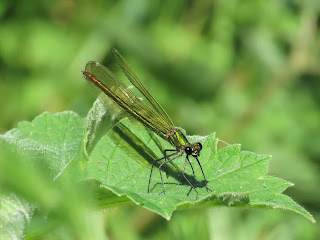Having heard that RSPB reserve at Otmoor has just opened (partially) I got up early this morning to pay a visit. Arriving at 8 am it was already warm and sunny as I made my way towards up the main track to the bridleway, which is the part that is open. I could hear a cuckoo in the distance and a few warblers in the hedges, and saw a sedge warbler singing from its perch on a telegraph wire.
Reaching the junction with the bridleway, I enquired if the turtle doves had returned this year, as I didn't manage to see one last year. I was told 'Yes, it was here 15 minutes ago but has flown off onto the marsh!!' The area where I stopped was by some cattle pens and seed is put out for it to encourage it. However there were several wood pigeons and mallards devouring it, so I shouldn't think there would be much left! Although I waited it didn't return, and I didn't even hear it purring from the large oak trees as on previous occasions. Continuing along the bridleway, I noted lapwings, a redshank, three shovelers, reed warblers and reed buntings. After the junction with the paths to the hides and screens I got talking to someone who said there were some dragonflies around. in particular hairy dragonflies if I kept an eye out along the ditches. I continued and several metres further on a dragonfly flew along the edge of the ditch before settling on a bush just in front of me. I took some photos and then the man who I'd spoken to caught up with me and confirmed it was a hairy dragonfly.
Looking the other side of the ditch, were lots of goose families, both greylag and Canada geese. I also caught sight of a hare lolloping off into the long grass. On my return down the bridle way I found a further dragonfly which I believe is a female ruddy darter.
I checked the area for the turtle dove again, but it wasn't to be seen, A few people had seen a bittern in the reeds, and were standing waiting to see if it reappeared, so I waited a little while but felt a bit intrusive joining them, as it wasn't a hide or viewing screen.
I was a little disappointed not to see either cuckoo or turtle dove, but at least I had two new dragonfly species to add to my list.
hairy dragonfly
ruddy darter
view across Otmoor. Several goose families in this area























































.JPG)
